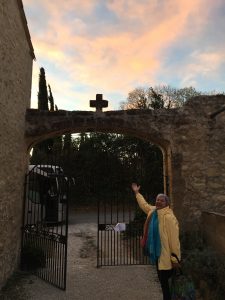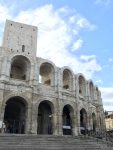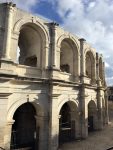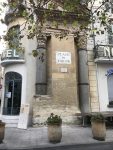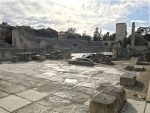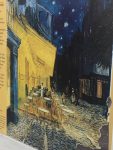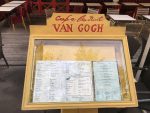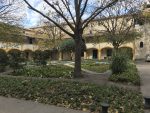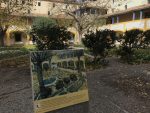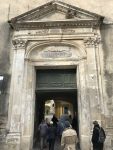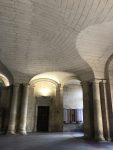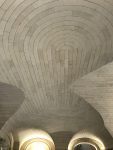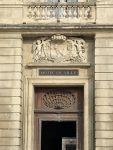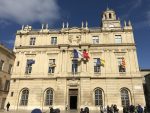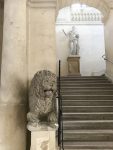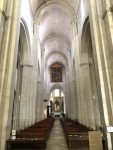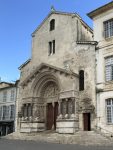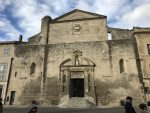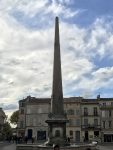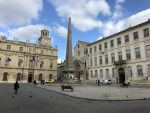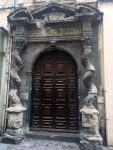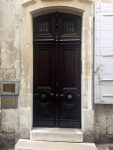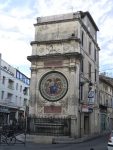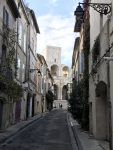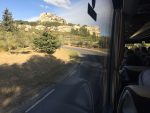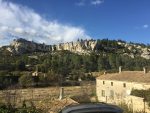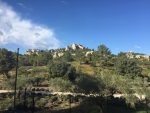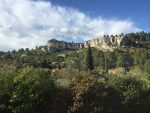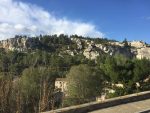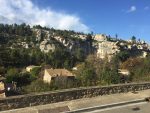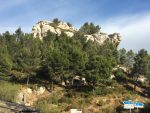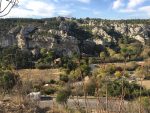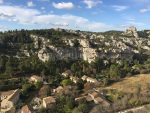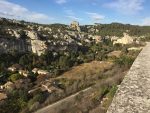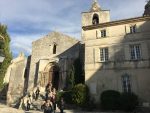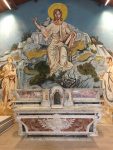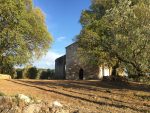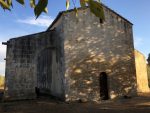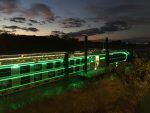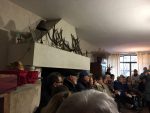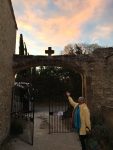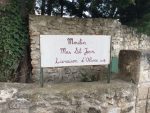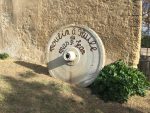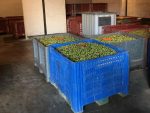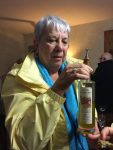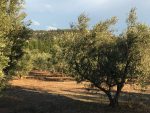Burgundy and Provence
Monday
Arles, Les Baux, and Olives
 This was an absolutely fabulous day, in spite of sleeping late (until after 7:00!) and fighting le mistral all day. We lived in Nice for a while in 1985, but I guess we were too far East to have experienced it before. There were times during the afternoon when I thought if I just grabbed the bottom of my jacket and held out my arms, I could fly away. We had to walk uphill and against the wind to board the bus. When we got to Arles, we fought the wind the rest of the morning. In the afternoon, we fought the wind on the steep streets of Les Baux. The only respite we got from the wind was when we were indoors.
This was an absolutely fabulous day, in spite of sleeping late (until after 7:00!) and fighting le mistral all day. We lived in Nice for a while in 1985, but I guess we were too far East to have experienced it before. There were times during the afternoon when I thought if I just grabbed the bottom of my jacket and held out my arms, I could fly away. We had to walk uphill and against the wind to board the bus. When we got to Arles, we fought the wind the rest of the morning. In the afternoon, we fought the wind on the steep streets of Les Baux. The only respite we got from the wind was when we were indoors.
And it was worth it! All day long.
Arles
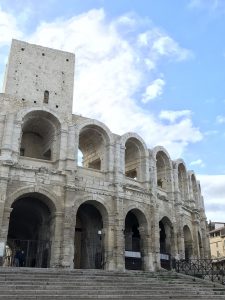 The ship had moved from Avignon to Tarascon, to the south a few miles, during the night. We got to see a lot of Tarascon as we were bussed back and forth to various destinations.
The ship had moved from Avignon to Tarascon, to the south a few miles, during the night. We got to see a lot of Tarascon as we were bussed back and forth to various destinations.
Our morning visit to Arles was short, but altogether interesting and enjoyable. Judy and I went with different guides, and it was fun to meet up at several points and trade comments. Our group started off walking along the river, seeing the remains of the Lion Bridge, and walking through one of the remaining gates in the medieval city walls. After we gawked our way along the streets for a while, we reached some of the Roman structures that still stand, at least in part, in the city. The Amphitheater is still in use today, and it’s the site of the local Bull games in Arles. Yep. BULL games. From the description our guide gave us, I think these games would be fun to watch; boys chase the bulls to snatch ribbons from them. The bulls aren’t killed as they are in bull fights. No toreadors or picadors here. The remains of the Roman theater are used for more peaceful activities concerts and plays. And the Roman Obelisk and Fountain are standing whole and complete in the main square. There’s not much remaining of the Roman forum, though—just two columns and a pediment. They look sort of lonely. But most people who make it to the Forum Square aren’t there to see the columns; they’re there to see the Yellow Café.
 The only thing I knew about Arles before we got there involved Vincent van Gogh. I knew he had been hospitalized somewhere near there and that he painted sunflowers while in Arles. As it turns out, the bus had parked near the area where he lived, though the house no longer stands. The Yellow Café is still there, however, and they’ve even painted the facade yellow to attract more tourists. It’s really kind of neat to think that a painting where he used yellow to represent the light shining on the awning from below has actually changed the look of the place. There’s a placard with a reproduction of the painting near the café itself, and I enjoyed seeing it alongside the redecorated building. When her group was there, Judy even had her picture made standing among the tables, and believe me, she’s wrapped up because of the wind, not because of freezing temperatures.
The only thing I knew about Arles before we got there involved Vincent van Gogh. I knew he had been hospitalized somewhere near there and that he painted sunflowers while in Arles. As it turns out, the bus had parked near the area where he lived, though the house no longer stands. The Yellow Café is still there, however, and they’ve even painted the facade yellow to attract more tourists. It’s really kind of neat to think that a painting where he used yellow to represent the light shining on the awning from below has actually changed the look of the place. There’s a placard with a reproduction of the painting near the café itself, and I enjoyed seeing it alongside the redecorated building. When her group was there, Judy even had her picture made standing among the tables, and believe me, she’s wrapped up because of the wind, not because of freezing temperatures.
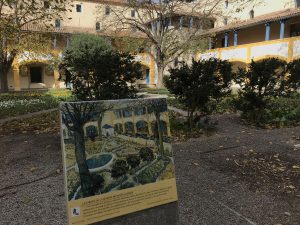 We also visited the hospital where van Gogh stayed for a while. I learned a new term—Hôtel Dieu. That’s the term used in the past for hospitals, and it’s a term we would run into later on this trip. The courtyard is remarkably unchanged from one of van Gogh’s paintings, and it was fun to see another reproduction displayed there for all to see.
We also visited the hospital where van Gogh stayed for a while. I learned a new term—Hôtel Dieu. That’s the term used in the past for hospitals, and it’s a term we would run into later on this trip. The courtyard is remarkably unchanged from one of van Gogh’s paintings, and it was fun to see another reproduction displayed there for all to see.
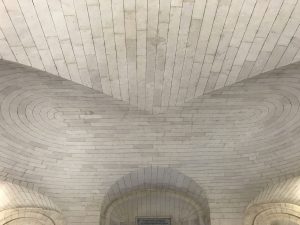 On the way to the Hôtel Dieu, my group walked through the ground floor of the Hôtel de Ville, the 17th-century town hall of Arles. I’ve seen a lot of buildings like this, but the ceiling of this room amazed me. It’s made of stone blocks cut precisely and lined up without mortar. The design is fascinating, made up of several intersecting, incomplete arches and vaults. I think this is supposed to be one of the world’s largest rooms in such historic buildings that has a stacked stone ceiling without any interior columns for support. When we had a little free time later in the morning, I had to go back and stare at the patterns the blocks made. Fascinating!
On the way to the Hôtel Dieu, my group walked through the ground floor of the Hôtel de Ville, the 17th-century town hall of Arles. I’ve seen a lot of buildings like this, but the ceiling of this room amazed me. It’s made of stone blocks cut precisely and lined up without mortar. The design is fascinating, made up of several intersecting, incomplete arches and vaults. I think this is supposed to be one of the world’s largest rooms in such historic buildings that has a stacked stone ceiling without any interior columns for support. When we had a little free time later in the morning, I had to go back and stare at the patterns the blocks made. Fascinating!
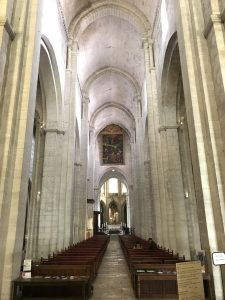 After our visit to the hospital, we had some free time, so I wandered around some, stopped in for a coffee in a shop not for from the square, then headed back to the Hôtel de Ville, just to get my second look at the ceiling. The square is also the site of a Roman obelisk and fountain, as well as a 12th-century church, St. Trophime. (I’ll have to find out who St. Trophime was. That’s a name I’d never seen before.) The sculptured doorway is really great, and the interior surprised me with its overall height. All other aspects of the building screamed “Romanesque,” but the height of the nave was stunning in context.
After our visit to the hospital, we had some free time, so I wandered around some, stopped in for a coffee in a shop not for from the square, then headed back to the Hôtel de Ville, just to get my second look at the ceiling. The square is also the site of a Roman obelisk and fountain, as well as a 12th-century church, St. Trophime. (I’ll have to find out who St. Trophime was. That’s a name I’d never seen before.) The sculptured doorway is really great, and the interior surprised me with its overall height. All other aspects of the building screamed “Romanesque,” but the height of the nave was stunning in context.
After our visit was over, we went back through Tarascon to the ship for lunch before heading out for the afternoon. As it turned out, the afternoon visits were even more fun than the morning.
Les Baux-de-Provence
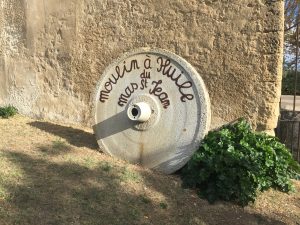 The afternoon started off with several bus rides, some planned, some made extemporarily. After lunch we fought the wind again, walking uphill to board the busses before we headed out to Mas St. Jean, an olive farm near the village of Fontvieille. We got there, were told there had been an accident in the mill and clean-up was in progress, re-boarded the busses, and headed out to Les Baux-de-Provence, which was supposed to be our second destination of the afternoon. Flexibility is good, right? Then, when the decision was made to swap destinations and go on to Les Baux, we discovered that the driver had driven off to park somewhere he wouldn’t block the narrow road. Who knows how far away that might have been, in the middle of olive groves for miles. That’s when modern technology had a small triumpf. One quick cell phone call and he turned around, coming back to save the day. Well–the afternoon at least.
The afternoon started off with several bus rides, some planned, some made extemporarily. After lunch we fought the wind again, walking uphill to board the busses before we headed out to Mas St. Jean, an olive farm near the village of Fontvieille. We got there, were told there had been an accident in the mill and clean-up was in progress, re-boarded the busses, and headed out to Les Baux-de-Provence, which was supposed to be our second destination of the afternoon. Flexibility is good, right? Then, when the decision was made to swap destinations and go on to Les Baux, we discovered that the driver had driven off to park somewhere he wouldn’t block the narrow road. Who knows how far away that might have been, in the middle of olive groves for miles. That’s when modern technology had a small triumpf. One quick cell phone call and he turned around, coming back to save the day. Well–the afternoon at least.
A short diversion here. I have spent many hours driving through countrysides in Europe and the British Isles, keeping my eyes on the road and missing some passing scenery. I really enjoy being a passenger now, so that I can turn my head left and right at will and see what’s out the side window instead of the road. On the other hand, when I was driving, I often made unscheduled stops so we could all look around easily and get some photos we would have missed without pausing in our drive. I guess there’s always a trade-off. In this case, it meant I didn’t have to drive on those narrow switch-backs, but I also couldn’t stop and take photos of the Château or drive up the opposite hill to take a photo of the village itself. C’est la vie.
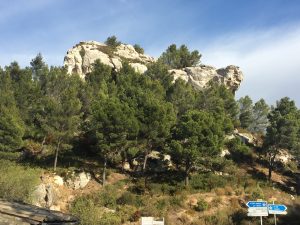 Les Baux is one of the “Perched Villages” of Provence, the type of place Judy and I were familiar with from our drives around Nice in the Côte d-Azur. I don’t recall running into this before, so I was surprised that the village was actually not part of France but owned by the Grimaldi family. At least it was owned by the Grimaldis until recently, when Prince Rainier sold it back to France. Crazy.
Les Baux is one of the “Perched Villages” of Provence, the type of place Judy and I were familiar with from our drives around Nice in the Côte d-Azur. I don’t recall running into this before, so I was surprised that the village was actually not part of France but owned by the Grimaldi family. At least it was owned by the Grimaldis until recently, when Prince Rainier sold it back to France. Crazy.
When we got out of the bus, half-way up a hill, about where the walls of the village started, I guess, we were hit again by le mistral. As we walked up the twisting little streets, we either felt the wind stronger or just got some relief, depending on how close we were to a wall that blocked the wind roaring down from the north.
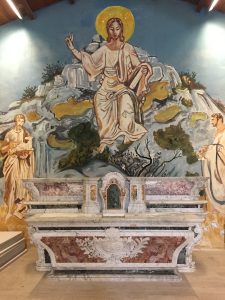 The little village is typical of many we’ve seen before, and a lot of it reminded us of Eze. As a group, we went in the small church near the top of the hill, and I was surprised to see some later Gothic modification to what was clearly a church built before the beginning of the 13th century. The most striking thing was the windows, donated by Prince Rainier, and I must have been completely distracted because I didn’t get a single photo of them.
The little village is typical of many we’ve seen before, and a lot of it reminded us of Eze. As a group, we went in the small church near the top of the hill, and I was surprised to see some later Gothic modification to what was clearly a church built before the beginning of the 13th century. The most striking thing was the windows, donated by Prince Rainier, and I must have been completely distracted because I didn’t get a single photo of them.
Then we went into a small chapel, with an ornate altar that must have been built in by an Italian. The surprise here was the walls, which had been covered in much more recent murals. The scenes were all associated with the Nativity story, but set in this landscape. Really nice to look at, and this time I at least got one photo.
As the group sort of dissolved, Judy and I poked around a little more. We made it into a few shops as we wandered downhill, eventually stopping to buy some candy to bring home. Honesty compels me to mention that we also bought a couple of candied fruits: a fig and a clementine. Absolutely delicious.
Olives at Mas St. Jean
When we left Les Baux, the bus took us on a drive along the other side of the hill, where we could look back (quickly) and see the ruins of the chateau that was the major stronghold of the village. Then we drove back through another village and through farm land on the level plane at the bottom of the hill, to get back to the olive farm we had left earlier.
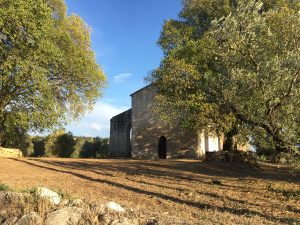 When we reached the farm the second time, we started out walking to a small, medieval, private chapel located at the edge of one of the olive groves. We sat on benches along the walls and were introduced to Magali Sourdon, one of the two sisters who now manage the company. The mill and olive oil business has been in their family for ten generations, and it was fun to hear her describe the events that led to two women taking over a traditionally “man’s job.” On top of that, Magali is a master olivier and a taster for the jury that oversees the local protected Appellation for the Baux de Provence valley.
When we reached the farm the second time, we started out walking to a small, medieval, private chapel located at the edge of one of the olive groves. We sat on benches along the walls and were introduced to Magali Sourdon, one of the two sisters who now manage the company. The mill and olive oil business has been in their family for ten generations, and it was fun to hear her describe the events that led to two women taking over a traditionally “man’s job.” On top of that, Magali is a master olivier and a taster for the jury that oversees the local protected Appellation for the Baux de Provence valley.
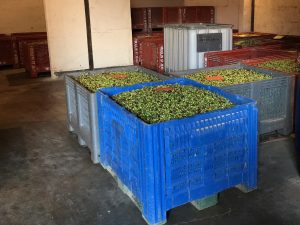 When we left the chapel, we had time to wander a bit through the trees, before moving into the mill and tasting room. We didn’t go in through the main gate, which would have taken us directly into the area where the shop is located. Instead we walked around back and entered through the area where fresh-picked olives are delivered to the mill. That’s where we saw huge crates of olives that had been delivered and sorted. My guess is those crates were about a meter on each side, so say something like 30 cubic feet of olives in each one. Green olives, brown olives, black olives, some leaves and maybe even a stem or two. Olives ready for the oil mill had orange cards on top, the others had green cards. Lots of olives, but what do you expect from 5,000 olive trees.
When we left the chapel, we had time to wander a bit through the trees, before moving into the mill and tasting room. We didn’t go in through the main gate, which would have taken us directly into the area where the shop is located. Instead we walked around back and entered through the area where fresh-picked olives are delivered to the mill. That’s where we saw huge crates of olives that had been delivered and sorted. My guess is those crates were about a meter on each side, so say something like 30 cubic feet of olives in each one. Green olives, brown olives, black olives, some leaves and maybe even a stem or two. Olives ready for the oil mill had orange cards on top, the others had green cards. Lots of olives, but what do you expect from 5,000 olive trees.
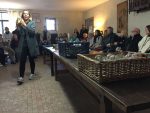 There a passage with glass walls that keep the slick modern mill and press area clean and safe from tourist-borne contaminants, and we walked past that on the way to the tasting room.
There a passage with glass walls that keep the slick modern mill and press area clean and safe from tourist-borne contaminants, and we walked past that on the way to the tasting room.
Oh my, we tasted some olive oil pressed earlier in the day, and though Judy and I had been to an olive oil tasting in Italy a few years before, that was nothing like this. A little bread, some olive oil, chased with a local rosé. The wind? Only a minor annoyance, and worth every minute of it just to get a couple of tastes. The delays in getting here? Nothing to be concerned about. The shop? That’s often something I don’t enjoy, but this one — wouldn’t have missed it.
All we had left in the day was a drive through the sunset back through Tarascon to the ship, where we had time to change before the Captain’s Welcome Reception and Dinner. After that it was off to bed after one of the busiest days I can remember in quite a while.
Where did they go? What did they see?
Arles and Les Baux de Provence

